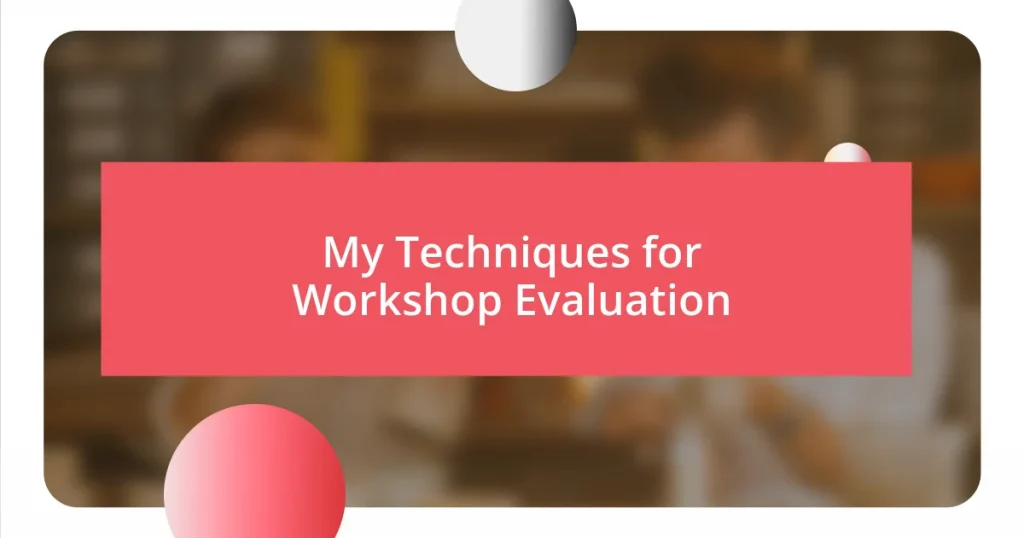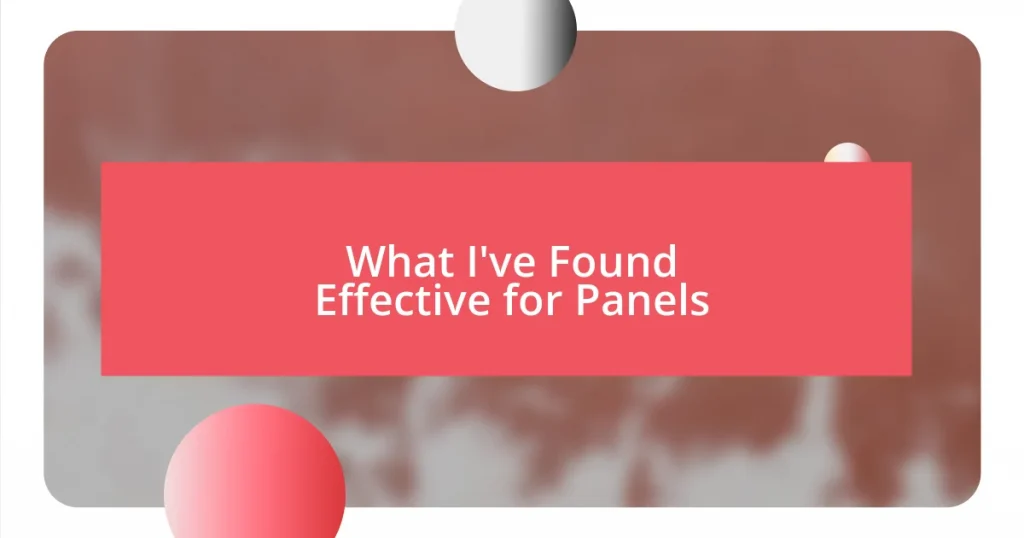Key takeaways:
- Effective workshop evaluation combines quantitative and qualitative feedback, enabling deeper insights and identifying areas for improvement.
- Clarity in evaluation criteria is essential to ensure reliable and specific feedback from participants, enhancing the evaluation process.
- Implementing changes based on participant feedback fosters engagement and shows commitment to continuous improvement, reinforcing the value of their input.

Understanding Workshop Evaluation Techniques
Workshop evaluation techniques are crucial for understanding the effectiveness of any program. I remember a time when I utilized feedback forms after a lengthy session, only to discover that participants felt lost during certain segments. This experience taught me that the right questions can unlock valuable insights, revealing areas for improvement I hadn’t considered.
When I think about different techniques, I often reflect on the power of peer observations. Watching a colleague deliver a workshop taught me so much about different styles and techniques. It made me wonder: how often do we take time to learn from each other in this way? This not only fosters a collaborative environment but also enriches the learning experience for everyone involved.
I’ve found that incorporating both quantitative and qualitative data in evaluations gives a fuller picture of workshop success. For instance, while numbers can tell you how many participants enjoyed the session, narrative feedback can convey the emotional impact it had on them. Have you ever read a comment that resonated so deeply it reshaped your approach? That’s the kind of insight that makes evaluations more than just a formality; they become a path to genuine growth.

Identifying Key Evaluation Criteria
When identifying key evaluation criteria, I’ve learned that clarity is essential. I recall a workshop where the criteria included vague terms like “engagement” and “satisfaction.” It was frustrating because participants had different interpretations, leading to confusing feedback. Establishing clear, specific criteria not only streamlines the evaluation process but also enhances the reliability of the insights gathered.
Here are some crucial evaluation criteria I typically focus on:
- Participant Understanding: Did they grasp the core concepts?
- Relevance: How applicable were the topics to their needs?
- Engagement Levels: Were participants interacting and asking questions?
- Facilitator Effectiveness: Did the instructor connect well with the audience?
- Actionable Takeaways: Did participants leave with practical insights they can apply?
By honing in on these areas, I’ve noticed that evaluating a workshop becomes more meaningful, creating a direct link between feedback and improvement.

Developing Effective Evaluation Tools
When developing effective evaluation tools, I find that the type of questions I ask plays a significant role in the quality of feedback I receive. For instance, instead of simply asking if participants enjoyed the workshop, I now ask what specific aspects resonated with them. This shift not only encourages deeper reflection but often uncovers feedback that surprises me. Just the other week, I implemented this approach and was thrilled to discover that a brief activity I thought was merely a filler had a profound impact on several attendees.
I’ve also experimented with various formats for collecting feedback. Surveys can be valuable, yet I’ve found that incorporating tools like interactive polls during the workshop keeps the energy high and the responses immediate. I remember one instance where we used a live polling app, and the instant visibility of the results sparked an engaging discussion right there in the room. It’s fascinating how blending different evaluation methods can create a more dynamic evaluation process.
Lastly, I believe in the importance of follow-up evaluations. Gathering insights immediately after a workshop is crucial, but so is checking in weeks later to see if participants applied what they learned. This continuous engagement not only reinforces their learning journey but also aids me in refining future sessions. One time, a participant reached out weeks later and shared how they implemented a technique I taught, which heightened my motivation to keep evolving as a facilitator.
| Evaluation Tool | Description |
|---|---|
| Feedback Forms | Traditional but effective, allowing participants to reflect post-session. |
| Interactive Polls | Engages participants in real-time, fostering discussion and immediate feedback. |
| Follow-Up Surveys | Gauges the long-term impact of the workshop, tracking application of knowledge. |

Collecting Feedback from Participants
Collecting feedback from participants is one of the most powerful tools I’ve found to enhance my workshops. After each session, I make it a point to have informal conversations with a few attendees. I love hearing their thoughts in a relaxed atmosphere — it often leads to candid insights that structured surveys might miss. Have you ever felt that a simple chat revealed much more than a cold questionnaire ever could?
I also craft my evaluations to invite storytelling. For instance, I recently asked a participant to share a moment they found particularly impactful. Their enthusiasm was palpable as they recounted how a specific exercise shifted their perspective. I realized then that feedback shouldn’t just be a series of numbers; it’s about understanding the narratives that make up those numbers. Doesn’t it make you curious to delve deeper into your own workshop experiences?
To make feedback collection more engaging, I sometimes introduce a creative element, like using colored cards where participants can express their feelings about various aspects of the workshop instantly. Just last month, one participant, visibly shy, lit up with her bright green card—indicating ‘excellent’ — when I asked about the facilitator’s approachability. It reminded me how crucial it is to create an environment where everyone feels comfortable sharing. Discovering those moments of genuine appreciation reinforces my commitment to improving. How do you gather those heartfelt moments from your sessions?

Analyzing Evaluation Data
Analyzing the evaluation data involves looking beyond surface-level numbers to uncover trends and insights. After gathering feedback, I like to categorize responses based on themes or specific topics that arise. For example, during a recent workshop, I was pleasantly surprised to find a recurring theme about the value of group discussions. This sparked my curiosity and led me to enhance that aspect in future sessions.
One method I use to dig deeper into the data is to create visual representations of the results. I often turn qualitative feedback into word clouds, which highlights the most common phrases participants use. Seeing words like “empowering” and “collaborative” pop up encourages me to tailor future workshops with those sentiments in mind. Have you noticed how visuals can help garner a more profound emotional connection with the data?
In addition, I find it incredibly valuable to compare evaluation data across different workshops. This longitudinal approach allows me to identify patterns over time. For instance, I once conducted a workshop series where I adjusted the content based on participant feedback from previous sessions. Analyzing that data not only led to consistent improvements but also enhanced my understanding of how participants engage with the material. Reflecting on this process makes it clear that evaluation isn’t just a box to check—it’s a key ingredient in fostering a richer learning experience.

Implementing Changes Based on Feedback
Making changes based on feedback is all about translating insights into practical adjustments. For instance, I once received comments about the need for more interactive activities in my workshops. I took those suggestions to heart and incorporated a series of hands-on exercises. The transformation was palpable; not only did the energy levels rise, but participants shared that they felt more engaged and invested. Isn’t it amazing how a few tweaks can lead to such significant impact?
When I implemented changes, I also made it a point to communicate those updates to my participants. After a workshop where many expressed a desire for more time to reflect on the exercises, I made a conscious effort to extend the debriefing sessions in my next workshop. I was genuinely surprised by the positive feedback. It felt rewarding to know that the adjustments resonated with them, affirming that their voices truly mattered. Have you ever experienced that moment when you realize your willingness to adapt directly enhances the participant experience?
Lastly, I believe in continuously reassessing the effectiveness of the changes I make. A few months back, I introduced a feedback loop, asking participants after each session how well the changes worked for them. This ongoing dialogue not only keeps me informed but also fosters a sense of community and collaboration. Reflecting on their responses reminds me that adapting is an evolving journey. How often do we pause to really listen and iterate on our methods?













